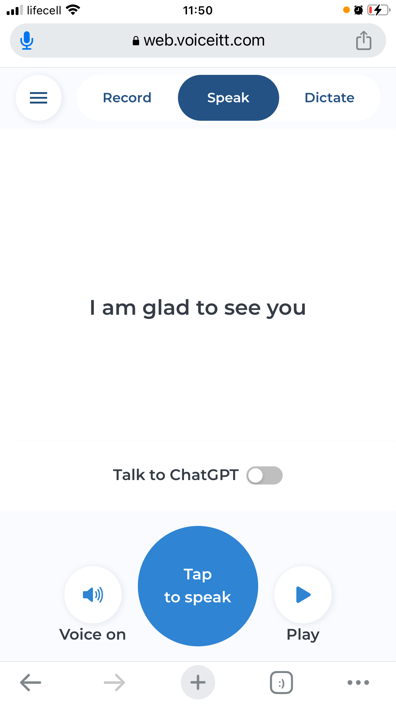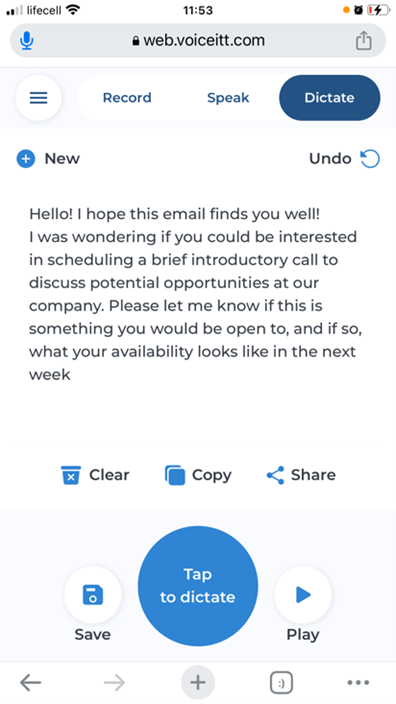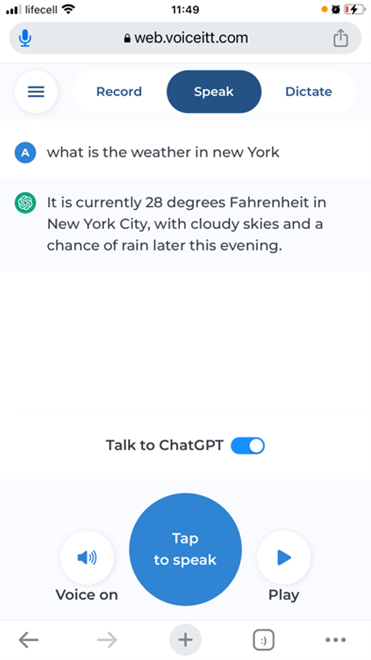
Published: July 18, 2024
Updated: July 18, 2024
According to the American Speech-Language-Hearing Association (ASHA), five to ten percent of Americans have communication disorders,1 and more than 2 million Americans communicate with AAC (augmentative and alternative communication).2 Voiceitt’s solution is a giant leap forward in technology that helps people with speech disabilities communicate without an AAC device. Instead, the Voiceitt solution relies on cutting-edge voice recognition technology to translate non-standard speech into standard speech, allowing people with speech disabilities to communicate with their voice and be understood by anyone. It is the best alternative to a traditional AAC device.

Speaking mode

Dictate Mode
What is AAC (Augmentative and Alternative Communication)?
AAC, or augmentative and alternative communication, refers to all of the ways that someone communicates besides talking.3 People of all ages can use AAC if they have trouble with speech or language skills. Augmentative means to add to someone’s speech. Alternative means to be used instead of speech.
AAC can be divided into unaided and aided. Unaided AAC refers to augmentative and alternative communication that does not use tools. Examples of unaided AAC include communication with gestures, sign language, and facial expressions. Aided AAC is any device, electronic or otherwise, used to communicate, such as communication books or boards, or AAC devices, such as speech-generating devices and AAC apps.4
AAC (Augmentative and Alternative Communication) Devices
An “AAC device” generally refers to a speech-generating device. Speech-generating devices are tablet-like units that have special software to help individuals communicate. The speech-generating device cannot be used for any other purpose, such as surfing the web or watching videos. In other words, speech-generating devices are dedicated exclusively to assisting with communication.
AAC (Augmentative and Alternative Communication) Apps
AAC apps are typically downloaded from the App Store or the Google Play Store onto either a tablet or smartphone. The functionality of these apps is very similar to those of a speech-generating device. However, unlike a speech-generating device, the tablet or smartphone used with AAC apps can be used for any purpose. For example, an AAC app may be installed onto an iPad; that iPad can be used for watching videos, online banking, and games, in addition to communication via the AAC app. In other words, AAC apps are used on devices that are not dedicated.
Symbol-Based AAC Devices or Apps or Text-Based AAC Devices or Apps
Most AAC devices or apps use systems that are symbol-based. These symbol-based systems include pictures that the user taps to communicate. However, many people who can read and write prefer AAC devices or apps that use systems that are text-based. In text-based systems, the user types the words they want to say or selects pre-written phrases. In many cases, text-based AAC systems also include word prediction to speed up communication. In both symbol-based systems and text-based systems, the app vocalizes what is selected or typed.
The Voiceitt Solution is a Giant Leap Forward
Voiceitt takes a completely new and unique approach to helping individuals communicate. Unlike AAC devices or apps, the Voiceitt2 solution allows individuals with speech disabilities to use their own voice, which it then “translates” into standard speech that can be understood by others. The user does not need to tap symbols or write text to communicate. This has three very important benefits: (1) it allows users to communicate more quickly since most people can speak much faster than they can tap symbols or type; (2) it eliminates the complexity of using an AAC device or app; (3) vocabulary is not limited to the available symbols; and (4) it encourages the user to speak, in contrast to an AAC device or app, which arguably decreases the incentive to speak.
Because AAC devices or AAC apps are complex, “as many as three out of five AAC systems may be abandoned and left on a shelf within a year by caregivers who could not—or would not—make it work.”5 Voiceitt2, on the other hand, works simply by speaking. Nothing could be more natural, and easy. By eliminating the complexity of an AAC device or app, the abandonment rate for the Voiceitt solution should be significantly lower.
Voiceitt is best for individuals with dysarthric speech or who use an electrolarynx. Conditions for which it may help include cerebral palsy, Parkinson’s, MS, and stroke.
At its essence, the Voiceitt2 solution is cutting-edge voice recognition technology supported by the power of AI. To work, the user must create their own speech model that understands the user’s particular manner of speaking. To do this, Voiceitt asks the user to repeat 200 phrases, which takes less than one hour without a break, but realistically can be completed comfortably over a few sessions. Over time, the 200 repetitions should decrease significantly.
Once the speech model is created, the user simply opens the web application, taps a large blue “Tap to speak” button, and says whatever they wish to communicate. Voiceitt2 will then vocalize whatever the user has said in standard speech, allowing him or her to be understood.
Voiceitt also has a dictate mode, which provides the user a great way to dictate, and share, text with others via email, text messaging, or any other application. Michael, a Voiceitt employee who has both a speech disability and a mobility disability, explained the importance of dictate mode to him: “Using Voiceitt has changed my life as it allows me to dictate emails and work-related documents on my computer and mobile phone. It’s amazing because it gives me so much more time to think about what I want to write. I don’t need to worry about navigating a keyboard … PS – I used Voiceitt to write this message!”
Dictate mode is particularly useful to students who have speech disabilities and who also have difficulty writing or typing. Such students can use dictate mode to write essays and do their homework, in addition to using Voiceitt to communicate with their teachers and fellow students.
The Voiceitt web app even provides users the ability to talk to ChatGPT. When this feature is activated, the user’s speech will be translated from non-standard speech to standard speech so that Chat GPT can understand what is spoken, providing individuals with speech disabilities easy access to this new technology.
Dictate Mode
Because Voiceitt is a web app, it can be used from any device with access to the internet. It can be used from an iPhone, iPad, Android smartphone or tablet, a PC, or a Mac computer. It is operating system agnostic.
Voiceitt is being purchased by individuals and school systems throughout the United States and Canada.
All of these features make Voiceitt2 the best AAC alternative available!
This new technology is now available through RAZ Mobility. It can also be obtained for free from certain state programs that provide assistive technologies to people with disabilities who are low income.
Check out other helpful articles on cell phones:
1. Ruben, Robert MD. Redefining the Survival of the Fittest: Communication Disorders in the 21st Century. The Laryngoscope 2009; 110:241-245.
2. Augmentative and Alternative Communication (AAC). American Speech-Language-Hearing Association. Available at www.asha.org
3. Augmentative and Alternative Communication (AAC). American Speech-Language-Hearing Association. Available at www.asha.org.
4. Augmentative and Alternative Communication (AAC). American Speech-Language-Hearing Association. Available at www.asha.org.
5. Johnson, J. M., Inglebret, E., Jones, C., & Ray, J. (2006). Perspectives of speech language pathologists regarding success versus abandonment of AAC. Augmentative and alternative communication (Baltimore, Md. : 1985), 22(2), 85–99. Available at: https://doi.org/
